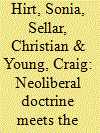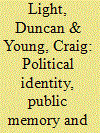| Srl | Item |
| 1 |
ID:
122819


|
|
|
|
|
| Publication |
2013.
|
| Summary/Abstract |
THIS COLLECTION EXPLORES HOW NEOLIBERAL IDEOLOGY-and related economic policies-have been implemented in the once-socialist countries of East Central Europe and the former Soviet Union. Specifically, it argues that this ideology undergoes deep modifications as it meets post-socialist conditions: sometimes it is creatively appropriated, sometimes resisted and sometimes 'purified' (in that it is implemented more thoroughly than in the Western nations where neoliberalism as an ideology was developed). Thus, the collection illustrates how 'actually existing neoliberalism', to use Brenner and Theodore's (2002) terminology, occurs 'on the ground'. It argues that the 'actually existing neoliberalisms', which have developed in a variety of post-socialist contexts, can differ profoundly from the theoretical constructs propagated by neoliberalism's supporters, including the major international financial institutions such as the International Monetary Fund and the World Bank. As recent literature on policy mobility makes clear 'It is already widely recognized that it is rarely possible to transfer policies directly, precisely because they emerge from and are responses to particular "local" sets of social and political conditions which are not replicated in the places to which they are transplanted' (Cochrane & Ward 2012, p. 5).
|
|
|
|
|
|
|
|
|
|
|
|
|
|
|
|
| 2 |
ID:
099636


|
|
|
|
|
| Publication |
2010.
|
| Summary/Abstract |
This article analyses the inter-relationship between political identity, public memory and urban space in South-east Europe through a case study of Parcul Carol I (Carol I Park) in Bucharest, Romania from 1906 to the present. The article analyses how the urban cultural landscape has been reshaped to support the political ambitions of three successive regimes-Romania as a kingdom and liberal constitutional monarchy (1881-1938); state-socialist Romania (1947-1989); and the post-socialist Romanian state from 1989. The article highlights complex continuity from the state-socialist period under post-socialism, rather than destruction of the landscape of state-socialism, combined with the return of pre-socialist landscape elements. The article argues for the need for studies of the fate of state-socialist urban landscapes under post-socialism which consider the complexities introduced by the persistence of landscape elements from the pre-socialist and state-socialist periods and their combination with pre-socialist and post-socialist landscapes to produce hybrid memory-scapes and spaces of the nation.
|
|
|
|
|
|
|
|
|
|
|
|
|
|
|
|